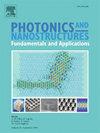利用圆对称设计大型超透镜的加速近场数据采集
IF 2.5
3区 物理与天体物理
Q3 MATERIALS SCIENCE, MULTIDISCIPLINARY
Photonics and Nanostructures-Fundamentals and Applications
Pub Date : 2025-02-01
DOI:10.1016/j.photonics.2025.101364
引用次数: 0
摘要
由于计算资源的限制,研究人员在研究大型超透镜时,特别是那些明显大于工作波长的超透镜时,往往会绕过模拟结果的验证。通常,他们可能会直接使用模拟衍生单元或在进行全面实验之前使用较小规模的超透镜进行初步验证。为了解决这一挑战,我们提出了一种加速近场数据采集阶段的方法,这通常是最耗时的。这涉及到通过在圆形图案中对称展开一维超构透镜来构建二维近场数据。我们的研究结果表明,这种方法可以实现超过100倍的加速,随着超构透镜尺寸的增加,效率可能会更高。此外,该方法还适用于多层衍射透镜的计算。在未来,我们的方法有望为研究人员提供更准确的数据来指导实验设计,从而增加成功的可能性。本文章由计算机程序翻译,如有差异,请以英文原文为准。
Accelerated near-field data acquisition for designing large metalenses using circular symmetry
Due to limitations in computational resources, researchers often bypass the validation of simulation results when investigating large metalenses, especially those significantly larger than the operational wavelength. Typically, they might directly employ simulate-derived units or perform preliminary validation using smaller-scale metalenses before advancing to full-scale experiments. To address this challenge, we propose a method to accelerate the near-field data acquisition phase, which is often the most time-consuming. This involves constructing two-dimensional near-field data by symmetrically expanding a one-dimensional metalens in a circular pattern. Our findings show that this approach can achieve a speedup of over 100 times, with potential for even greater efficiency as metalens size increases. Additionally, this technique is applicable to the computation of multi-level diffraction lenses. In the future, our method is expected to provide researchers with more accurate data for guiding experimental designs, thereby increasing the likelihood of success.
求助全文
通过发布文献求助,成功后即可免费获取论文全文。
去求助
来源期刊
CiteScore
5.00
自引率
3.70%
发文量
77
审稿时长
62 days
期刊介绍:
This journal establishes a dedicated channel for physicists, material scientists, chemists, engineers and computer scientists who are interested in photonics and nanostructures, and especially in research related to photonic crystals, photonic band gaps and metamaterials. The Journal sheds light on the latest developments in this growing field of science that will see the emergence of faster telecommunications and ultimately computers that use light instead of electrons to connect components.

 求助内容:
求助内容: 应助结果提醒方式:
应助结果提醒方式:


